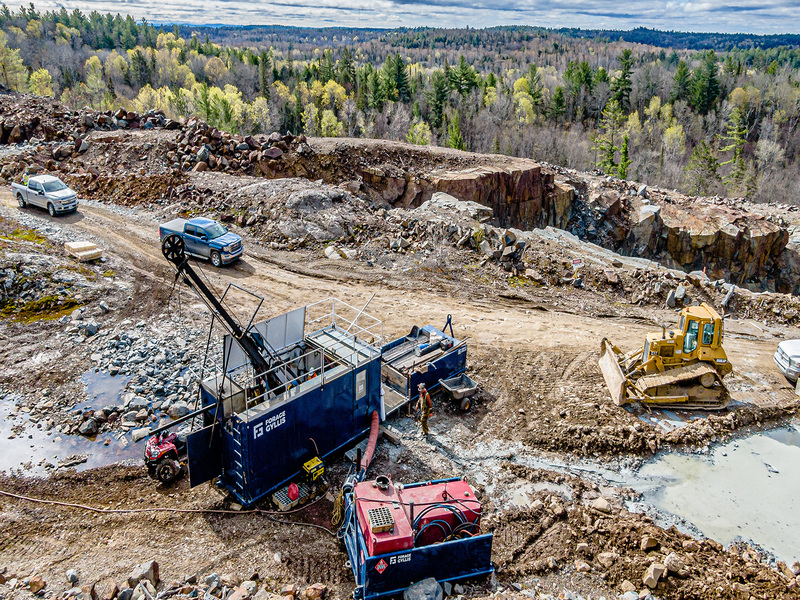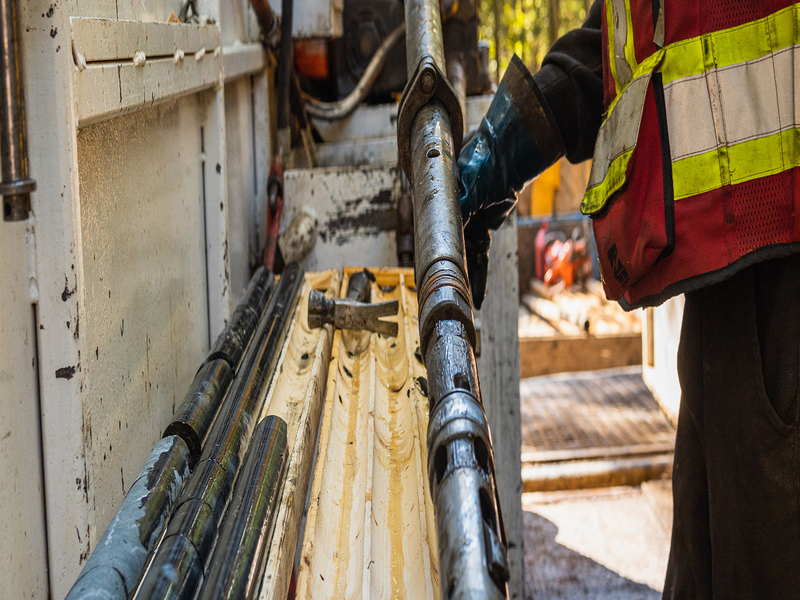Shakespeare is a past producing Nickel-Copper-PGM project located around 70km southwest of Sudbury in Ontario, Canada.
The project started commercial production in May 2010 and terminated in January 2012 due to fall in base metals prices.
Magna Mining, the current owner of the property, announced the results of a feasibility study in January 2022. The study confirmed the potentiality of the Shakespeare Project as a stand-alone operation at 2022 nickel and copper prices.
The mine is expected to produce 65.7 million pounds of nickel, 86.7 million pounds of copper, 3 million pounds of cobalt and 177,000 oz of platinum-group metals (PGM).
Project Gallery
-

The Shakespeare Nickel-Copper-PGM Project is located in Ontario, Canada. (Credit: Magna Mining Inc.)
-

Drilling work at the site. (Credit: Magna Mining Inc.)
-

The mine is expected to produce 65.7 million pounds of nickel, 86.7 million pounds of copper, 3 million pounds of cobalt and 177,000 oz of PGM. (Credit: Magna Mining Inc.)
The development of the project will entail an initial investment of C$232.9m including all mine pre-production costs, co-disposal area preparation and sustaining capital of C$9.2m (including closure).
Location and Site Details
The Shakespeare Project is located in the Shakespeare Township in Ontario towards the north and east of Agnew Lake. It can be accessed by the Trans Canada highway.
The nearest town is Webbwood, located 9km southwest of the property. leading into Sudbury in Ontario.
The project has key permits for the construction of a 4,500tpd mill and restart open pit mining at the site. It also includes a surrounding land of 180km2, which is highly prospective for further nickel, copper, and PGM discoveries.
Ownership History of the Shakespeare Project
Frobisher Exploration staked the property in 1941 and conducted surveys, mapping, and diamond drilling in the area of the west zone for the next several years.
Falconbridge Nickel Mines (now Glencore) acquired the claims from Frobisher in 1947 and commenced exploration on the property.
In 1986, Falconbridge concluded that the project could not meet the various economic parameters required to move the project forward.
No further work was conducted on the property until 2000 when it was acquired by Ursa Major Minerals via a joint venture agreement with Falconbridge.
Magna Mining was formed in 2016 and it acquired Ursa Major Minerals in early 2017, thereby gaining the ownership of Shakespeare Project.
In January 2022, Mitsui & Co signed a non-binding memorandum of understanding (MoU) to examine acquiring a 10 to 12.5% interest in Magna’s Shakespeare Mine for a cash consideration of $8-10m.
Geology and Mineralisation
The copper‐nickel deposit at Shakespeare occurs within gabbroic rocks of the Nipissing Intrusive Suites situated along the north contact between the mafic intrusive body crossing the property and quartzites of the Mississagi Formation.
The Shakespeare intrusion hosts semi-massive to disseminated sulphides.
The sulphides, including pyrrhotite, chalcopyrite, pentlandite, and lesser pyrite, are present in varying proportions throughout the intrusion.
The accumulations present in the property are in the form of disseminations of pyrrhotite, chalcopyrite, and pentlandite close to the melagabbro/gabbro contact.
Heavily disseminated to patchy net-textured pyrrhotite, chalcopyrite, and pentlandite in rounded blebs are found in the upper zone of the melagabbro, while the lower sections of the melagabbro and the base of quartz gabbro contain blebby pyrrhotite and chalcopyrite.
Shakespeare Project Mineral Reserves
With a cut-off grade of 0.2% nickel equivalent (NiEq), the indicated open pit mineral resource estimate for the Shakespeare deposit is 16.5 million tonnes, 0.34% nickel (Ni), 0.36% copper (Cu), 0.02% cobalt (Co), 0.33g/t platinum (Pt), 0.36g/t palladium (Pd), 0.19g/t gold (Au).
The indicated mineral resource estimate (underground), at cut-off grade of 0.4% NiEq, is 3.8 million tonnes grading 0.31% Ni, 0.36% Cu, 0.02% Co, 0.30g/t Pt, 0.32g/t Pd, 0.19g/t Au, and 0.53% NiEq.
The total mineral reserve (proven + probable) is estimated at 11.87Mt grading 0.33% Ni, 0.35% Cu, 0.02% Co, 0.32g/t Pt, 0.36g/t Pd, and 0.18g/t Au.
Mining and Ore Processing
The Shakespeare project is planned as an open pit operation using conventional mining equipment that will include the use of haul trucks and excavators among others.
The minerals will be processed in a processing plant, designed as a conventional crush/grind/float operating with a throughput of 4,500tpd.
Mine haul trucks will feed the recovered ore into a surge bin which feeds a primary jaw crusher. The crushed ore is conveyed to the SAG mill.
The SAG mill is equipped with a pebble crusher and operates in closed circuit with a vibrating screen to achieve a transfer size of 1,000µm.
The screen undersize reports to the ball mill circuit comprising an overflow discharge ball mill closed with cyclones. The cyclone overflow, at a P80 of 85µm, gravitates to the flotation circuit conditioning tanks to adjust pH.
The first three tank flotation cells of rougher‐scavenger circuit will be used to recover a bulk sulphide concentrate and the last three cells to recover nickel scavenger concentrate.
The bulk rougher concentrate undergoes one stage of bulk cleaning. It is followed by two stages of copper flotation for producing the final copper concentrate product.
The bulk circuit cleaner tails are combined with the nickel scavenger rougher concentrate and reground before nickel cleaner flotation.
The final nickel concentrate product will be produced by combining the nickel scavenger concentrate with the copper cleaner tailings.
The final copper and nickel concentrates will be then thickened and filtered, and then sent in bulk to a smelter.
Project Infrastructure
The Shakespeare project infrastructure will include the construction of a new 4,500tpd process plant and a Co-Disposal Area (CDA) which will have an area for combined waste rock and tailings storage, associated site roads, platforms, helipads, and administrative buildings.
The project will not require camp facilities due to its close proximity to the neighbouring towns and the city of Sudbury.
Power will be supplied by 115kV hydropower grid with a take-off to the southwest of the project at a new 115kV/44kV substation that will be built northeast of Webbwood.
A liquid filled transformer will step down 115kV voltage to 44kV for supplies to the mine.
The process plant area new substation will receive power from a 7.5km overhead transmission line.
Contractors involved
The feasibility study for the nickel-copper-PGM project was prepared by AGP Mining Consultants.
Other contributors include SGS Canada, XPS Consulting and Testwork Services, Blue Coast Research, SLR Consulting (Canada), and Halyard.
